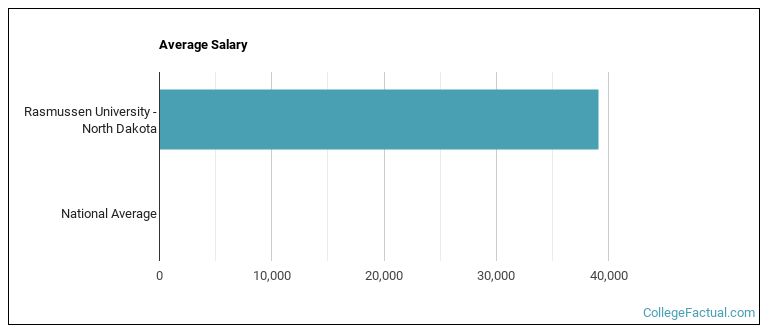 by our College Data Analytics Team
by our College Data Analytics Team
College Factual analyzes over 2,000 colleges and universities in its annual rankings and ranks them in a variety of ways, including most diverse, best overall quality, best for non-traditional students, and much more.
Rasmussen University - North Dakota was awarded 21 badges in the 2025 rankings. The highest ranked major at the school is nursing.
Explore the best ranked schools for the programs you are most interested in.
According to College Factual's 2025 analysis, Rasmussen University - North Dakota is ranked #252 out of 2,152 schools in the nation that were analyzed for overall quality. This puts it in the top 20% of all schools in the nation. This is an improvement over the previous year, when Rasmussen University - North Dakota held the #1,036 spot on the Best Overall Colleges list.
Rasmussen University - North Dakota is also ranked #2 out of 12 schools in North Dakota.
See all of the rankings for Rasmussen University - North Dakota.
Rasmussen University - North Dakota has an open admissions policy, so you should not have much trouble being accepted by the school. Still, it is important to fill out the application completely and submit any requested materials, which may include proof that you have a high school diploma or the equivalent.
The student to faculty ratio is often used to measure the number of teaching resources that a college or university offers its students. The national average for this metric is 15 to 1, but at Rasmussen University - North Dakota it is much better at 11 to 1. That's good news for students who want to interact more on a personal level with their teachers.
Another measure that is often used to estimate how much access students will have to their professors is how many faculty members are full-time. The idea here is that part-time faculty tend to spend less time on campus, so they may not be as available to students as full-timers.
The full-time faculty percentage at Rasmussen University - North Dakota is 22%. This is lower than the national average of 47%.
The freshmen retention rate of 100% tells us that most first-year, full-time students like Rasmussen University - North Dakota enough to come back for another year. This is a fair bit higher than the national average of 68%. That's certainly something to check off in the good column about the school.
During the 2017-2018 academic year, there were 619 undergraduates at Rasmussen University - North Dakota with 337 being full-time and 282 being part-time.
The net price is calculated by adding tuition, room, board and other costs and subtracting financial aid.Note that the net price is typically less than the published for a school. For more information on the sticker price of Rasmussen University - North Dakota, see our tuition and fees and room and board pages.
It's not uncommon for college students to take out loans to pay for school. In fact, almost 66% of students nationwide depend at least partially on loans. At Rasmussen University - North Dakota, approximately 78% of students took out student loans averaging $6,995 a year. That adds up to $27,980 over four years for those students.
Get more details about paying for Rasmussen University - North Dakota.

See which majors at Rasmussen University - North Dakota make the most money.
Get more details about the location of Rasmussen University - North Dakota.

Contact details for Rasmussen University - North Dakota are given below.
| Contact Details | |
|---|---|
| Address: | 4012 19Th Avenue Sw, Fargo, ND 58103-7196 |
| Phone: | 701-277-3889 |
| Website: | https://rasmussen.edu/ |
| Most Popular Majors | Bachelor’s Degrees | Average Salary of Graduates |
|---|---|---|
| Nursing | 144 | $74,861 |
| Practical Nursing & Nursing Assistants | 29 | NA |
| Accounting | 28 | $53,285 |
| Business Support & Assistant Services | 23 | NA |
| Business Administration & Management | 20 | $59,693 |
| Teacher Education Grade Specific | 18 | NA |
| Health & Medical Administrative Services | 18 | $46,361 |
| Human Resource Management | 11 | $56,465 |
| Human Services | 11 | $40,125 |
| Legal Support Services | 10 | NA |
Online learning is becoming popular at even the oldest colleges and universities in the United States. Not only are online classes great for returning adults with busy schedules, they are also frequented by a growing number of traditional students.
In 2022-2023, 457 students took at least one online class at Rasmussen University - North Dakota. This is a decrease from the 543 students who took online classes the previous year.
| Year | Took at Least One Online Class | Took All Classes Online |
|---|---|---|
| 2022-2023 | 457 | 278 |
| 2021-2022 | 543 | 312 |
| 2020-2021 | 627 | 349 |
| 2018-2019 | 586 | 263 |
Learn more about online learning at Rasmussen University - North Dakota.
Footnotes
*The racial-ethnic minorities count is calculated by taking the total number of students and subtracting white students, international students, and students whose race/ethnicity was unknown. This number is then divided by the total number of students at the school to obtain the racial-ethnic minorities percentage.
References
More about our data sources and methodologies.